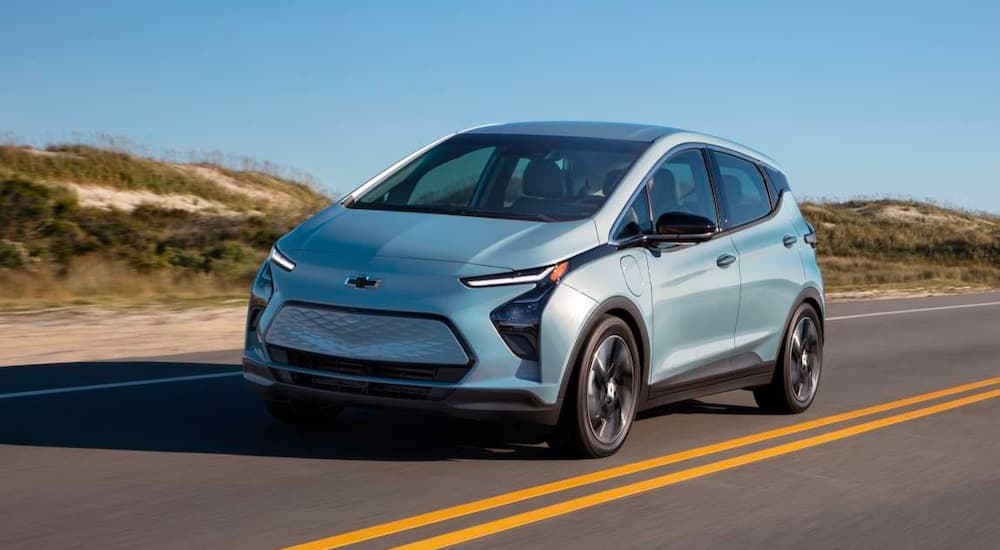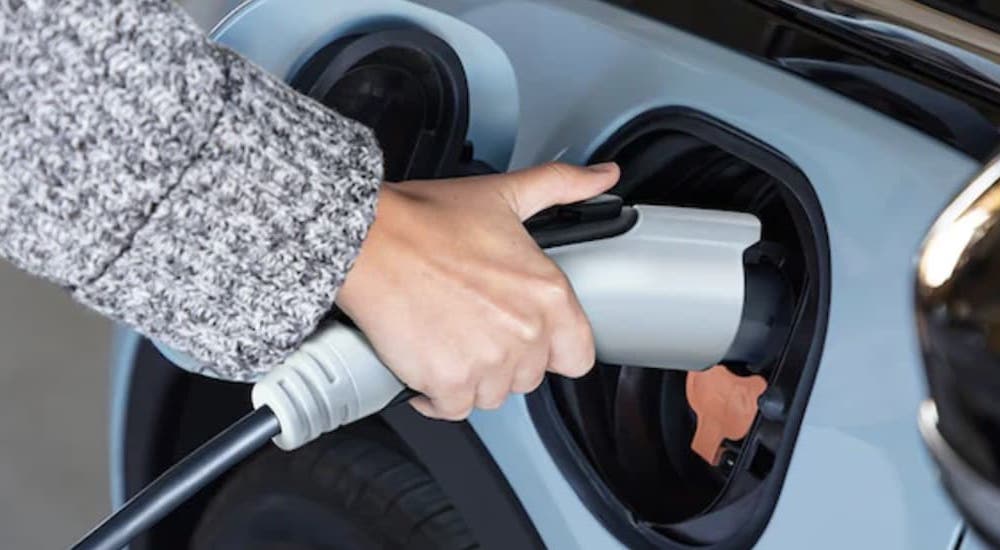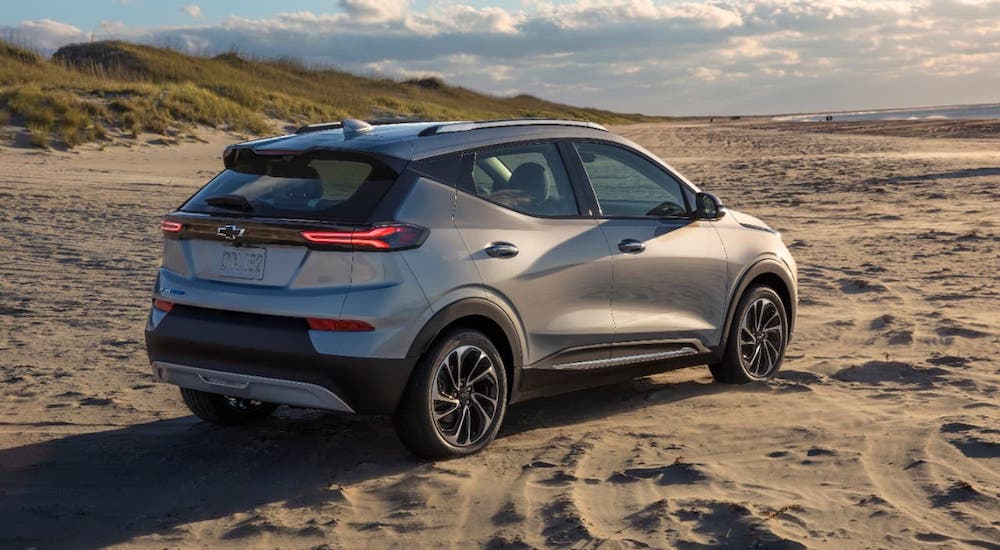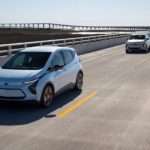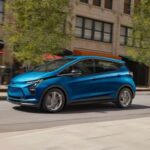For many, one-pedal driving is something you might associate with bumper cars at an arcade or maybe the first little battery-operated vehicle your parents gave you as a toddler to ride around the front yard in. However, one-pedal driving is an important part of current-day, made-for-adults, road-ready vehicles – electric vehicles, to be exact. If you’re interested in a Chevy Bolt EV or Bolt EUV, Chevy’s all-electric subcompact hatchback and subcompact SUV, one of the features you might notice is the one-pedal driving. The associate at your local Chevy dealer will be able to show you how to activate it.
Many drivers are still hesitant to use one-pedal driving. It’s certainly a weird sensation to just let the brake pedal sit there while the gas pedal does all the work. However, one-pedal driving is a very beneficial feature to have in your electric vehicle (EV). If you can learn how to use it effectively and safely, you’ll probably learn to love it. Even though most of this information should be in your vehicle user’s manual, we all know that few people actually read that roughly 170-page, fine-print document. So here’s a rundown on the basics of one-pedal driving.
What Exactly Is One-Pedal Driving?
One-pedal driving allows you to accelerate, slow down, and even come to a complete stop using just the gas pedal; you never touch the brake pedal. When you want to accelerate, you push down on the gas pedal. When you want to slow down, you ease up. And when you’re ready to stop, you remove your foot from the gas pedal completely. The mechanics behind one-pedal driving can get complicated, but in electric vehicles, one-pedal driving allows your vehicle to recapture some of the energy that’s usually lost during hard braking and send it to the battery, extending the range of your EV.
If you’ve ever driven a gas-engine vehicle and found yourself thinking, “What a waste of energy,” each time you had to come to an abrupt stop, you can imagine the beauty in one-pedal EV driving. You don’t have to waste energy just because you’re in stop-and-go traffic. In fact, you can turn that type of driving into energy that your battery uses. One-pedal driving has been shown to boost the mileage of the Bolt EV by roughly five percent.
What Are Other Perks of One-Pedal Driving?
When you use just the accelerator to speed up, slow down, and stop, you don’t have to move your foot back and forth between the gas and the brake pedals. If you spend a lot of time in stop-and-go traffic, that simple motion can become exhausting – quickly. Many drivers like giving their leg a break from, well, braking.
One-pedal driving can also encourage better driving habits. Your accelerator cannot do a hard brake as effectively as your actual brake (and for the record, you can and should still use your real brake in emergencies). Coming to a stop requires a little extra planning when you’re using one-pedal driving. So, you’ll have to get accustomed to beginning the process of easing up off the accelerator and coming to a stop gradually, which, technically, is the safest way to come to a stop. If you have a bad habit of going as fast as possible until the last moment and then hard braking, one-pedal driving can help you break that habit.
One-pedal driving also improves the lifespan of your brakes. If you typically do a lot of hard braking, switching to one-pedal driving gives your brakes some time off and helps them last longer. Your mechanic will wonder why you don’t have to replace our brake pads as often as you used to.
It’s Important to Train Yourself in One-Pedal Driving
At this point, you’re pretty used to how your brake and accelerator feel and how they respond to your movements. Braking and going is practically part of your muscle memory by now. However, you’ll need to develop a new type of muscle memory to use one-pedal driving. Recognizing how quickly the gas pedal responds to you pressing on it or taking your foot off it for slowing and stopping takes some getting used to.
Before going out on busy roads, practice one-pedal driving in a large parking lot or on a quiet residential street. You need to learn how early to take your foot off the gas if you want to come to a stop and how responsive the system is to requests for acceleration. And just a note: one-pedal driving works in reverse mode, too. So, when you’re backing out of a driveway, you can use just the gas pedal. This, too, takes some getting used to, so just be sure to have lots of practice time before hitting public roads.
Safety Considerations
As mentioned previously, you should still use your regular brake pedal for hard braking in emergency situations. It will remain active even when your vehicle is in one-pedal driving mode. Do not use one-pedal driving when going downhill. The vehicle might speed up at a less predictable rate than when you’re on even terrain, and hard braking could be the safest option on a slope. You must also refrain from using one-pedal driving on icy or slippery roads. Remember that, on icy roads, if your vehicle begins to slide, you typically take your foot off the gas. It’s what you’ve been trained to do. However, in one-pedal mode, doing so is the same as braking the vehicle, which is dangerous on slippery roads.
Some EVs have received criticism because their brake lights do not come on during one-pedal driving. This is a natural concern because brake lights tell the drivers behind you that you’re coming to a stop – which is especially important in low-light settings. Fortunately, the Bolt EV and Bolt EUV’s brake lights do activate when the vehicle substantially slows down in one-pedal driving mode. Always be aware of whether or not your vehicle is in one-pedal driving mode. Some drivers accidentally forget to turn it on and begin driving as if it is activated, which can be dangerous.
One-Pedal Driving Saves Your Car and You Much-Needed Energy
The back-and-forth motion of taking your foot off the accelerator, putting it on the brake, and returning it to the accelerator is simply exhausting. If you live somewhere with a lot of traffic and are subject to the rush hour commute, you probably get a leg cramp when all is said and done. One-pedal driving can relieve you of this headache by letting you speed up, slow down, and stop without ever moving your foot away from the accelerator.
If you want to get the maximum range out of your EV, you’ll also want to use one-pedal driving whenever it’s appropriate. It will boost your battery range, meaning you can go just a little further before you have to pull over and plug in. As EVs become more popular, drivers must become accustomed to all sorts of new technology, from charging ports to one-pedal driving. However, it seems EVs are the way of the future, so there could be a lot of one-pedal driving in the days ahead. Once you get the hang of it, you may never want to return to regular driving again.
